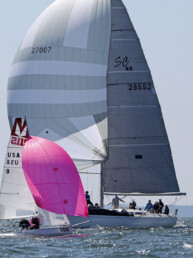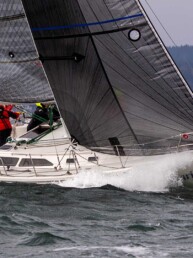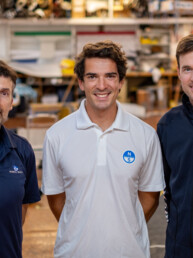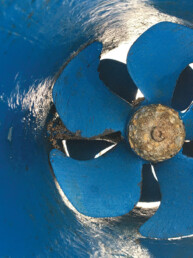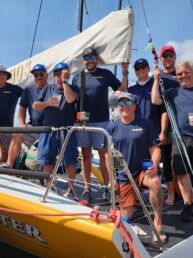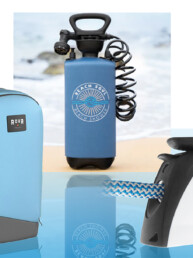From the June 2022 issue of 48° North.
“Sailing is 90% boredom and routine punctuated by 10% heart-pumping adrenaline.” Hearing this adage from our sailing mentor had the effect of both assuaging and alarming me and my wife, Laura — both new to sailing. If it were true that even experienced sailors face challenges, then we felt like we were in good company, although it seemed that our percentage of heart-pumping adrenaline far exceeded the 10% mark. At the same time, we worried that no matter how much we improved, there would always be unexpected events that might bring panic into an otherwise pleasant outing.
In the first few months of owning Ariel, our 1973 28-foot Columbia sloop, excitement about being on the water always seemed tempered with uncertainty and concern. Simple frustrations on the boat were followed by apprehensions that often made us wonder about our progress as mariners. Maneuvering the boat into and out of her slip was one of those concerns initially, made no less worrisome by the advice people offered us when under power: “Move only as fast as you’d be comfortable hitting something.” OK, well, not really helpful, but we had to assume that boats colliding with each other happens on occasion and, if it happened to us, we wouldn’t be the first.
Heeding that advice, I learned to shift the motor out of gear well before I approached our slip, coasting in neutral under a slow crawl. Making long, slow turns allowed me time to make any adjustments necessary to my course. As the boat gently approached the finger pier, Laura was able to easily step from the boat and cleat the dock lines. Once the boat was securely moored, the storing of gear and cleanup became routine and comfortable, almost…
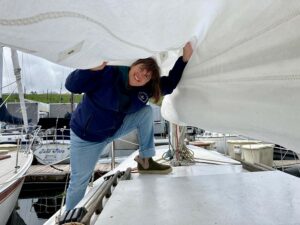
The next challenge for us to deal with occurred at the end of each sailing adventure just before we returned to port. Dropping the almost-new, stiff mainsail proved to be a daunting and frustrating task. Even in a calm breeze, the sail’s massive surface area overwhelmed us, draping itself across the hatch and forward cockpit area. The crisp, rigid, and nearly frictionless fabric was unwieldy in its response to our commands to subdue it. Even when we were able to awkwardly flake it over the boom, its bulges, swale, and rolls obscured our view as we motored into the harbor and, once moored, thwarted our efforts to apply its cover.
Even after untying and reflaking the sail once in port, we rarely ended up with the result we wanted. What we were looking for was a symmetrically uniform and balanced package of Dacron fabric. But what we ended up with looked like a collapsed circus tent with the support poles still inside. We were determined to tame the triangular beast, which had become our white whale, although not because of our drive for perfection. Rather, we felt that its appearance represented our measure as sailors, a sign of competence displayed proudly and triumphantly in full view of our dock mates and onlookers.
As renowned Welsh yachtsman, Roy Williams, often notes, “A tidy boat is a happy boat.” Whether coiling a Flemish Flake on the finger pier or looping a hanging coil onto a winch or cleat, we discovered by experience and through the advice of fellow sailors that we were creating not just a tidy and happy boat, but one whose organization improved the ease with which we sailed and, as a consequence, our enjoyment and relaxation. As a more important bonus, we were told that routine procedures create muscle memory that, when needed in an emergency, reduces the time and uncertainty that could potentially turn a small problem into a full-blown crisis.
Eventually Laura and I began to understand that the sail needed to develop its own “muscle memory”, too. Because, while Ariel was an older vessel, her mainsail was practically new, with little or no crease marks — good for sailing, bad for novice flaking. By folding it wrong several times over the course of a few months, we had created a faulty memory for the sail’s pattern and stowed position. The previous owner, to her credit, purchased the new sail about a year before selling her to us, but I have to believe that she hoisted and flaked the sail very few times, which probably wouldn’t have been a problem for experienced sailors. But for us, it meant developing the flake pattern on our own. Was there a wrong way? Would it damage or affect the sail somehow? Not to be beaten by sail cloth, we kept at it, determined to become better sailors and caretakers of Ariel.
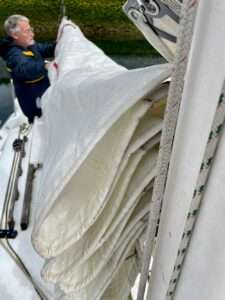
We knew that a systematic and streamlined process for flaking the main would be a big part of that seamanship. So we read up on the methods for the task, watched the prerequisite YouTube videos, and studied the way our dock neighbors folded their mains. We even took them up on their offer to demonstrate the process on Ariel while she was moored, although the speed and facility with which they performed the feat nearly lost us. They made it look too easy, which is not always the best teaching method. Asking for more clarification, we were able to see the relationship between the sail slides and the accordion folds. Then once that alternating pattern was set, starting with the correct first fold, the battens became the focal point for adjusting the trailing edge to help locate its position on the boom, all the while applying tension at the aft point of the boom. Sounded good, in theory.
But our real understanding arrived unexpectedly when we casually invited an experienced racing sailor aboard Ariel for a brief afternoon outing on the bay. After hiring him to tune up our outboard motor, he came along to test it out, and then go for a sail. Offering to give us some pointers on sail trim, he was a fount of knowledge. When we told him that we had trouble folding the mainsail, he kindly offered to show us how, which he did, singlehandedly, in about 10 seconds. “So, that’s how you do it,” Laura and I responded with complete awe and admiration. I think we finally got it!
While we have greatly improved our methods for stowing the sails and docking, the tasks are not yet second nature. We don’t think that we’ll ever match the geometric perfection of the flake that our racing friend achieved. We didn’t sail for the next week or so, motoring so that we could enjoy the beautiful perfection of the flaked mainsail without disturbing it. When we finally hoisted the main and then dropped it again, we were apprehensive. But being conscious, focused, and patient helped produce a folded main that we were proud of.

As we develop our skill in other areas of caring for our vessel and sailing her with confidence, we are reminded by our mentor of the second part of the 90/10-boredom/terror quote: “Good sailors make even the adrenaline part look routine and boring.” We have a long way to go for that to happen, but now we’re not only proud of the “cut of our jib” but the flake of our main as well.
David Casey is a retired math teacher and semiprofessional woodworker and bass player. He plans on using his retirement to build a small sailboat and a kayak, and to explore the waters of southern Puget Sound.

